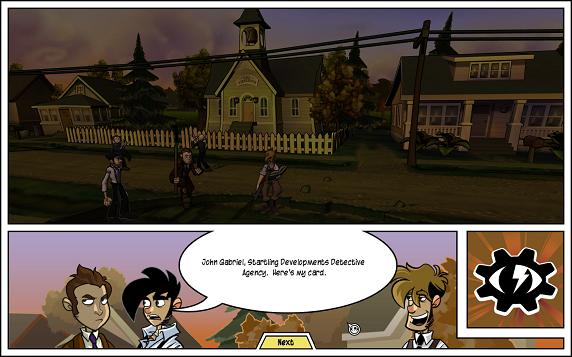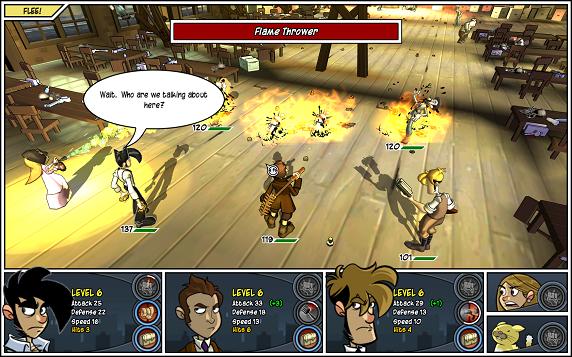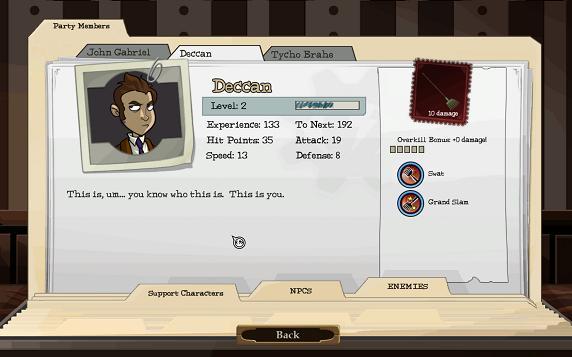
I’m not a regular reader of Penny Arcade. The comics are too hit and miss for me and I often don’t get many of the things they reference. But whenever someone cross posts a strip to QT3, I’m generally amused by what I see, so it’s not like Tycho and Gabe are totally unknown to me. On the Rain-Slick Precipice of Darkness (henceforth abbreviated as OTR) is basically an attempt to make a videogame of their own, featuring their art, writing and general style.
I bought the compilation of two episodes because I was intrigued by the idea of a Lovecraftian story done by the Penny Arcade team and because it’s been years since I’d last played an adventure game. I’d also read that the combat system used is similar to that of the Final Fantasy series which I have no exposure to beyond a combat demo many, many years ago, so I thought I’d use this to get a better idea of how those games work.
The result is generally rather disappointing. The game begins with the player character in the idyllic suburban neighborhood of Arcadia in the 1920s, an idyll that is suddenly shattered when a giant robot wanders in out of nowhere and stomps your house into splinters. Enraged, you chase after to robot only to run into Tycho and Gabe, special investigators specializing in weird phenomena of just this sort, and promptly join forces with them.

Despite the billing, the game is much more of an RPG, and a radically stripped down one at that, than an adventure game of the old-school style. There are no real puzzles. Instead, you run around the map, talk to every single character you see and bring them whatever they want, which are always objects that you obtain through combat. The plot then advances. Since this is Penny Arcade, they even have a good excuse for things being illogical. One supposed scientist for example wants a scale model of a Ferris wheel so he can urinate on it.
The combat system employs a mix of both real-time and turn-based modes that I find awkward. Only one character can act at a time but this is based on each character’s timer that counts down to when he is free to act. It’s a good thing you only have three characters in your party. Any more and you’ll be busy looking at all the dials so as not to miss an opportunity to act. Each character has a basic attack and various special attacks that are progressively unlocked throughout the game, though they’re all just variations of the same thing.
Reflexes and recognizing enemy animations come into play too. You can block attacks, thereby reducing the damage received, by hitting the spacebar at the right time. Time it just right and you even get a free counterattack. In addition, all special attacks need you to play a sort of mini-game to pull them off successfully. The better the special attack, the harder the mini-game becomes, so let’s hope your have quick fingers. Combat is trivial with normal enemies, especially since you can just spam healing items but without a combination of good blocking skills and liberal use of special attacks, boss battles are all but impossible.

Like all RPGs, you gain experience and levels as you defeat enemies. Unfortunately, you don’t get to choose what to upgrade. All of your stats go up according to a fixed schedule. You don’t even get to choose weapons. Each character has a set weapon, a garden rake for the player character for example, and that’s it. You can gather materials to upgrade your weapons but again, the upgrade path is completely fixed. Pretty much the only choices that you can make is when you design your character’s look at the beginning of the game and pick a name for him or her. It’s rather sad.
This leaves just the story and humor as selling points. I admit that I quite like the cartoonish graphics and I appreciated the novelty value of mucking around in a universe as conceived by Penny Arcade. But as amusing as it is to fight robots called fruit-fuckers who can be distracted by throwing oranges at them once or twice, this kind of humor can’t really last for the duration of a whole game. And things just get progressively crazier from there. One support character that you can recruit is a cat who most of the time only does 1 point of damage. But once in a blue moon, it freaks out and instantly annihilates all enemies on the screen. A mime asks you to collect invisible objects for him, which sounds kind of cool at first, but then you realize that it’s just loot that you get from beating enemies just like everything else.
Overall, while I won’t say that playing this was a complete waste of time, I don’t see myself ever playing Episode Two and I completely understand why the rest of the planned series turned out to be vaporware. Playing this also cemented my distaste for this sort of combat system, making me glad I never looked into the Final Fantasy games. But at least now I know where the idea of the Tycho and Gabe investigators for Arkham Horror came from.
3 Responses to “On the Rain-Slick Precipice of Darkness”
To be fair, the combat in OtRSPoD is painfully simple compared even to the earliest Final Fantasy games. Writing off that style of RPGs based on OtRSPoD is like writing off Yomi because of Rock-Paper-Scissors. There are layers of depth that the latter doesn’t even attempt.
I’m not trying to say that you’d like the genre if you played one of its best examples. Certainly not every type of game is for every person. I just want you to know that a game like this isn’t even in the same league as Final Fantasy 6 or Persona 4.
It’s not just the simplicity of the mechanics however. It’s the very idea of characters taking turns to act, the idea of positioning on the battlefield being completely irrelevant and the reflexes-based mini-games added into the mix. It’s just a weird form of abstraction that feels very Japanese and alien to me.
But a quick browse through the Wikipedia entry for Final Fantasy indicates that not every installment in the series uses this type of system. And yes, this is very much a personal quirk of mine. Often I’ll read the premise for a Japanese game and think that sounds cool, but then I completely fail to grok its mechanics. It’s happened many times, e.g. Lost Planet, Resident Evil 5 etc. About the only exception is the Monster Hunter series.
Reflex-based minigames are not a staple of the genre. Aside from the Mario RPGs, I mainly see them used by western developers who rightly feel their shallow interpretation of turn-based combat is lacking (see also: Costume Quest). Personally I think this is throwing away some of the strengths of turn-based systems, such as giving you time to carefully consider your actions and not demanding your attention at every moment. But then I tend to prefer turn-based systems in general.
I think it’s pretty cool that games are getting stylistically sophisticated enough for there to be these kinds of cultural divides in their design. It’s like how some people don’t really click with “foreign” cinema. I don’t think it’s as unique to you make it out to be. Japanese-style RPGs are very much out of favor among most gamers right now. I’m constantly listening to podcasts/reading blogs where people play some Japanese game that I loved and it just didn’t make sense to them. I think people like me who want to struggle with a foreign sensibility are the unusual ones.
Leave a Reply